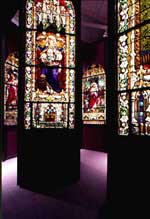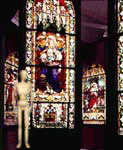VAM galleries including this work:
The Owensboro Museum of Fine Art | World of the Spirit || VAM Home
Emil Frei (German-American, 1869-1942)
MILDRED STOUT FIELD STAINED GLASS GALLERY
(16 stained glass windows), c. 1912
Individual window: 170" X 56"
A Gift of the Roman Catholic Diocese of Owensboro, Kentucky
Collection of Owensboro Museum of Fine Art
The 16 pictorial-style stained glass windows at OMFA were originally installed at St. Joseph Catholic Church on East Fourth Street in Owensboro between 1890 and 1912. They were made in the Munich, Germany, studios of Emil Frei. The Roman Catholic Diocese of Owensboro donated the windows to the museum when the church was torn down in 1989.
The intricate detailing, the vibrant colors, the stone tracery in the background around the figures (inspired by the marble altars in European Catholic churches), and the beautiful patina of the faces mark these windows as the work of this artist and his studio of craftsmen. The high degree of realism in the windows’ central figures was accomplished by use of the trace and matte technique of stained glass painting. Dating back more than 1,000 years, this method requires the application of blackish pigment to the colored glass sections. This pigment layer can create the illusion of a variety of textures and add light and dark areas to the glass. After each section of painted glass is subjected to a high-temperature firing, the two materials are permanently bonded together.
About the Artist
Emil Frei was born in Bavaria in 1869 and studied at the Munich Academy of Art before emigrating to the United States in the 1890s. After first working as a mural painter in San Francisco, he moved to St. Louis in 1898. There he worked briefly as an artist for the A.H. Wallis firm before starting his own company, Emil Frei Art Glass, in 1900. The windows Frei designed for Holy Family Church in Watertown, New York, won Grand Prize at the 1904 Louisiana Purchase Exposition, and he began receiving numerous commissions. By 1909, the company employed 15 artists and nine glass workers in studios in Munich and St. Louis.
According to Frei’s great-great-grandson, Steve Frei, the Owensboro windows were made at the pinnacle of pictorial glass. Although stained glass had been in existence since the Middle Ages, the smoothness of patina necessary for pictures wasn’t achieved until the early 20th century. Frei was known to use relatives as models for saints and angels. Craftsmen in his studios specialized; one might spend an entire career creating hands, faces, cloth, or architectural tracery.
Frei also made significant contributions to liturgical art through his work in mosaic design. In the 1920s, a commission to design mosaics for the new St. Louis Cathedral led him to join with Berlin art glass and mosaic firm Puhl U. Wagner to form Ravenna Mosaics Inc. The companies separated again in 1929. But with the involvement of Frei’s descendants, Emil Frei Inc. continued to build its reputation as one of the foremost designers of stained glass in the United States. Over time, its designs expanded to reflect modernistic and abstract influences.
Emil Frei died in 1942. The studio continues operation under the direction of great-great-grandsons David and Steve Frei, who restored the Owensboro windows before their installation at OMFA in 1994 and again after a fire at the museum in 2003.
Other examples of the work of Frei’s studio can be found at churches across the United States. In the Owensboro area, they include Holy Spirit Catholic Church, St. John Evangelical Protestant Church, St. Joseph Church, and St. Paul Church, all in Evansville, Indiana; St. Joseph Church in Jasper, Indiana; and St. Meinrad Abbey in St. Meinrad, Indiana.
Classroom Ideas
Discussion: Discuss the role that light plays in how we view stained glass. Compare these glass windows to the work of Jon Kuhn and Jean-Claude Novaro. Research and discuss the role and importance of liturgical art. What purpose or purposes of art do these windows represent? Compare these pictorial windows to other artworks in the Virtual Art Museum that convey religious scenes. Research what other types of artisans and craftsmen immigrated to America in the late 1800s. What examples of their work are found in your community?
Activity: Create a picture in stained glass or mosaic form.
Links
Find out more about Emil Frei and stained glass and view images of his work at the Emil Frei Inc. web site.
[www.emilfrei.com]
The Christ Episcopal Church web site (Bluefield, West Virginia) includes
an article on Munich-style windows.
[www.cecblf.org/munich.asp]
Learn about the history and art of stained glass at Stained Glass Quarterly Online.
[www.stainedglass.org/main_pages/sgaa/historySG.html]

